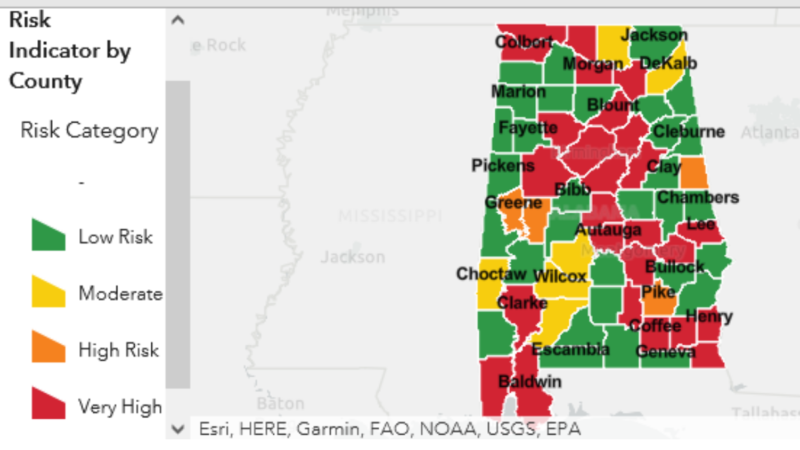Counties At Very High Risk Of COVID Spread Quadruples In 2 Weeks
The number of Alabama counties listed as being at “very high risk” for the spread of COVID-19 has quadrupled in the past two weeks, the state Department of Public Health reported Thursday.
ADPH listed six counties at ‘highest level of risk’ in its weekly report on June 24, but that total rose to 21 on July 1 and to 26 this week. The listings are based on statistics for the week ending the previous Saturday.
A county’s risk of COVID-19 spread is based on the number of new cases each day, calculated using the date of the onset of symptoms or the date a specimen was collected.
In addition to the counties listed as being at very high risk, four of the state’s 67 counties were listed as being at high risk, six at moderate risk and 31 at low risk.
The high-risk counties, spread across the state, are: Autauga, Baldwin, Blount, Chilton, Clarke, Coffee, Colbert, Crenshaw, Dale, Elmore, Henry, Houston, Jefferson, Lauderdale, Lee, Limestone, Macon, Marshall, Mobile, Montgomery, Morgan, St. Clair, Shelby, Talladega, Tuscaloosa and Walker.
Greene, Hale, Pike and Randolph counties were considered to be high risk.
Those shown as at moderate risk are Choctaw, Dallas, DeKalb, Madison, Monroe and Wilcox.
The number of new cases of the disease has grown statewide in recent weeks, reaching a total of 552,911 in Wednesday’s updated by ADPH. Alabama averaged 275 new cases a day over the past week, up from an average of 153 two weeks ago.
How Alabama Power kept bills up and opposition out to become one of the most powerful utilities in the country
In one of the poorest states in America, the local utility earns massive profits producing dirty energy with almost no pushback from state regulators.
No more Elmo? APT could cut ties with PBS
The board that oversees Alabama Public Television is considering disaffiliating from PBS, ending a 55-year relationship.
Nonprofit erases millions in medical debt across Gulf South, says it’s ‘Band-Aid’ for real issue
Undue Medical Debt has paid off more than $299 million in medical debts in Alabama. Now, the nonprofit warns that the issue could soon get worse.
Roy Wood Jr. on his father, his son and his new book
Actor, comedian and writer Roy Wood Jr. is out with a new book -- "The Man of Many Fathers: Life Lessons Disguised as a Memoir." He writes about his experience growing up in Birmingham, losing his dad as a teenager and all the lessons he learned from various father figures throughout his career.
Auburn fires coach Hugh Freeze following 12th loss in his last 15 SEC games
The 56-year-old Freeze failed to fix Auburn’s offensive issues in three years on the Plains, scoring 24 or fewer points in 17 of his 22 league games. He also ended up on the wrong end of too many close matchups, including twice this season thanks partly to questionable calls.
In a ‘disheartening’ era, the nation’s former top mining regulator speaks out
Joe Pizarchik, who led the federal Office of Surface Mining Reclamation and Enforcement from 2009 to 2017, says Alabama’s move in the wake of a fatal 2024 home explosion increases risks to residents living atop “gassy” coal mines.









